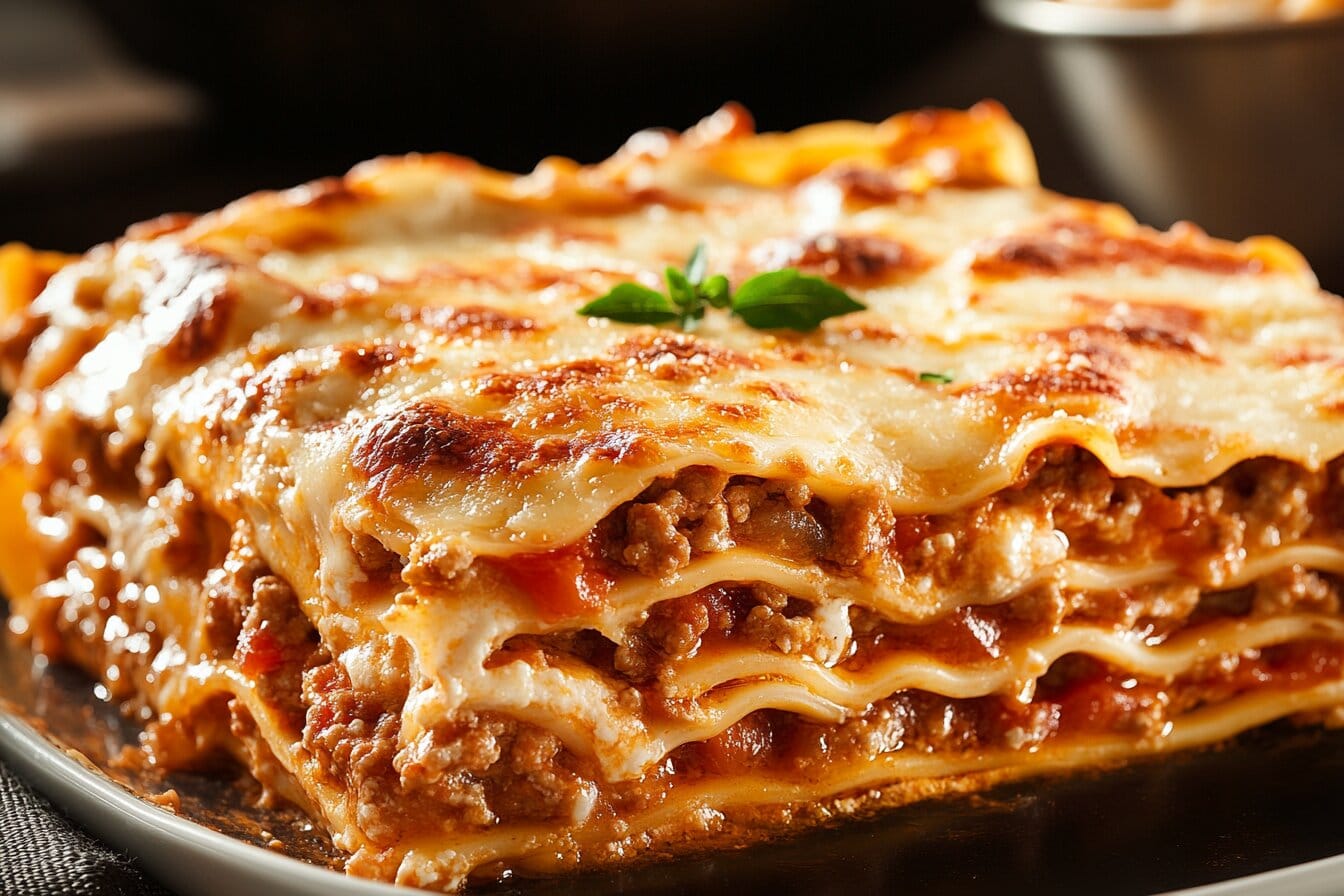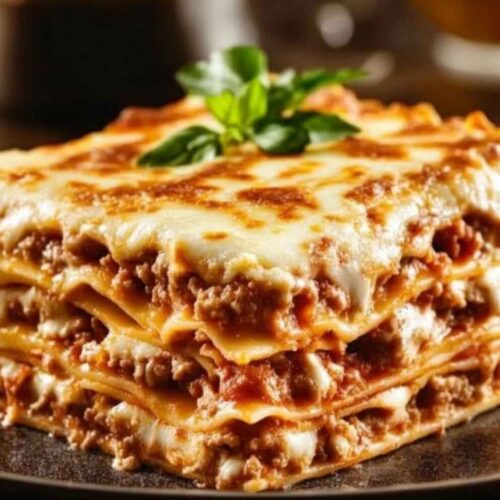There’s something magical about pulling a bubbling lasagna from the oven just as friends are pouring glasses of juice and the music’s playing softly in the background. It’s not just food — it’s a signal that something good is about to happen.
Lasagna is my go-to when I want to feed a crowd without stressing out. It’s the ultimate make-ahead meal, always a hit, and with Barilla’s oven-ready sheets, it comes together with zero boiling and zero fuss. Whether it’s a birthday dinner, a cozy Sunday with family, or just a “we need comfort food” kind of night — this Barilla lasagna recipe brings everyone to the table.
And when those golden, cheesy layers hit the plate? Trust me, there are never any leftovers.
Why I Swear by Barilla Lasagna Sheets
Barilla has been in my pantry for decades — and for good reason. Their oven-ready lasagna sheets cook up beautifully without pre-boiling (hello, time-saver!), and they hold their structure even after baking, so your lasagna doesn’t slide into a cheesy mess.
What Makes Them Special?
- No boiling needed — straight from the box to the baking dish
- Perfect texture — soft but never mushy
- Made with durum wheat semolina — that classic Italian bite
Barilla’s been around since 1877 — and it shows. Every time I use their pasta, it feels like I’m continuing a tradition.
Ingredients for a Classic Barilla Lasagna
Here’s what you’ll need for the ultimate comfort food dish:
Lasagna Layers:
- 1 box Barilla oven-ready lasagna sheets
- 3 cups marinara or meat sauce (see my homemade recipe below)
- 16 oz ricotta cheese
- 1 egg
- 2 cups shredded mozzarella
- ½ cup grated Parmesan
- Salt, pepper, Italian seasoning (basil, oregano, parsley)
Optional Add-ins:
- Sautéed spinach, mushrooms, or zucchini
- Cooked ground beef or sausage (if you want a meatier version)
Homemade Meat Sauce (Trust Me, It’s Worth It)
If you have 30 extra minutes, this simple meat sauce adds so much depth.
Ingredients:
- 1 lb ground beef or Italian sausage
- 1 small onion, chopped
- 3 cloves garlic, minced
- 1 (28 oz) can crushed tomatoes
- 2 tbsp tomato paste
- 1 tsp sugar
- Salt, pepper, Italian herbs
Instructions:
- In a large skillet, brown the meat. Drain excess fat.
- Add onion and garlic. Sauté until soft.
- Stir in crushed tomatoes, paste, sugar, and herbs. Simmer 25 mins.
- Taste and adjust seasoning. That’s it!
The Creamy Ricotta Layer
This is the layer that melts into every bite. It’s rich, savory, and holds the whole thing together.
Mix in a bowl:
- 16 oz ricotta
- 1 egg
- ¼ cup Parmesan
- 1 tsp parsley or basil
- Salt & pepper to taste
Let’s Layer This Baby!
Step-by-Step Assembly:
- Grease a 9×13 baking dish with olive oil or spray.
- Spread a thin layer of sauce on the bottom (so the noodles don’t stick).
- Add Barilla noodles, side by side — no overlapping.
- Spoon ricotta mixture evenly over noodles.
- Add sauce — not too much, just enough to cover.
- Sprinkle mozzarella + a dusting of Parmesan.
- Repeat steps 3–6 until you have 3–4 layers.
- Finish with sauce + cheese on top.
Baking Tips for Golden Perfection
- Cover with foil and bake at 375°F for 30 minutes.
- Remove foil and bake another 15–20 minutes until bubbly and golden.
- Let it rest for 10–15 minutes before slicing. (I know it’s hard to wait!)
Pro tip: Spray the foil with oil before covering the lasagna to keep the cheese from sticking.
Serving Suggestions
- A side of homemade garlic bread
- A crisp green salad with lemon vinaigrette
Garnish with fresh basil for that restaurant-worthy finish.
Variations You’ll Love
Vegetarian Lasagna
Swap the meat sauce for sautéed spinach, zucchini, or mushrooms.
Gluten-Free Lasagna
Barilla makes a delicious gluten-free version of their noodles — they work beautifully with this recipe.
Meat Lovers’
Add pancetta, sausage, and a little bacon for a bold, smoky twist.
Vegan Option
Use dairy-free ricotta, vegan cheese, and roasted veggies — still hearty and oh-so satisfying.
FAQ
How many layers is ideal?
3–4 layers usually fits a 9×13 dish perfectly
Why are my noodles gummy?
Make sure you’re using enough sauce Barilla’s oven-ready sheets need moisture to cook properly.
Do I need to pre-boil the noodles?
Nope! That’s the magic of Barilla’s oven-ready past
Why add milk or béchamel to lasagna?
To create a creamy balance and soften acidity in tomato sauces. Totally optional, but delicious.
This Barilla lasagna is more than a recipe — it’s a little slice of comfort, passed down from one dinner table to the next. Whether you’re making it for a birthday, a cozy Sunday supper, or just because, I promise this dish will bring smiles (and maybe seconds).
If you try it, I’d love to see it! Tag me on Instagram @GoldenDailyRecipes or leave a comment below. What’s your favorite lasagna twist?
Barilla Lasagne
Equipment
- 13×9-inch Baking Dish
- Saucepan
- Skillet
Ingredients
Bolognese Sauce
- 1 box Barilla Oven-Ready Lasagne
- 1/4 cup extra virgin olive oil
- 2 stalks celery chopped
- 1 medium carrot chopped
- 1 small onion chopped
- 3/4 pound ground beef
- 1/2 pound ground pork
- 1/2 cup dry white wine
- 3 cups water
- 1/3 cup tomato paste
- salt and freshly ground black pepper to taste
Béchamel Sauce
- 4 tbsp butter
- 4 tbsp flour
- 4 cups milk
- 1 cup grated Parmigiano cheese
Instructions
- Finely mince the onion, celery, and carrot. Sauté in olive oil for about 20 minutes.
- Add the ground beef and pork, cook until browned. Stir in wine and cook until reduced.
- Stir in tomato paste and water. Season and simmer for 90 minutes until thickened.
- In a saucepan, melt butter. Add flour and cook for 3 minutes. Gradually whisk in milk and cook until thick. Stir in Parmigiano cheese.
- Preheat oven to 350°F. Spread béchamel sauce in baking dish. Layer uncooked lasagna, béchamel, meat sauce, and cheese. Repeat for 5 layers.
- Bake uncovered for 25 minutes. Let rest 10 minutes before serving.


